STAFF — MARCH 13, 2015
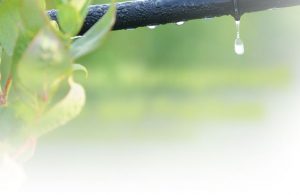
Irrigation water quality and efficient use of irrigation water are ongoing concerns for horticultural firms in the U.S. and across the globe. As competition for scarce water resources increases, risks of water shortages will also increase. As every nurseryman knows, access to sufficient safe irrigation water is a necessity, not an option. In addition, increasing attention is being paid to the quality of water runoff from irrigated agriculture. Irrigation water recycling is a practical step that businesses can use to improve water use efficiency. However, recycling can be costly, not only in terms of infrastructure but also of increased potential for disease pathogen buildup.
In response to these issues, the USDA Specialty Crop Research Initiative (SCRI) funded an integrated research and extension project (USDA Irrigation Pathogens and Water Quality #2010-51181-21140) involving seven universities that is designed to improve water use efficiency and protect the health of ornamental crops. Project objectives include the development of Best Management Practices (BMPs) to increase water recycling on horticultural operations and to mitigate water quality- related crop health risks. (More information on the project is available at http://www.irrigation-pathogens.ppws.vt.edu/.)
The project’s economics team surveyed Mid-Atlantic nursery growers in 2013 (see sidebar). The current article focuses on disease management practices and investigates the relationship between disease risk, disease management and recycling practices. The survey results indicate that nurseries are primarily concerned with financial risks resulting from disease outbreaks and insect infestation. Despite disease concerns, nurseries that recycle at least a portion of their irrigation and storm water runoff appear to have been more successful in avoiding major disease losses. Growers who currently do not capture and recycle consider high costs, increased disease risk and unsuitability of the nursery layout to be the principle barriers to recycling. The article also briefly discusses the project’s recommendations of best management practices for irrigation and disease management for recyclers and nonrecyclers alike.
Disease and insect infestation stand out among financial risk factors
Our project is particularly concerned with disease risks to nurseries. Respondents were asked to rate the individual importance of various threats of financial loss to their business: disease, drought, wind, frost, weeds, insects and hail. The responses were selected from an increasing scale ranging from “not important” to “very important.” Figure 1 shows the proportion of responses indicating that a threat was considered “important” or “somewhat important” by irrigation/recycling type and for all responding nurseries.
Across all nurseries, disease and insects are the causes of financial loss that approximately four in five respondents consider to be somewhat or very important. By irrigation/recycling type, a higher proportion of recyclers regard nearly every threat (except insects) as more important than do other types of nurseries. In general, however, there are only relatively small differences by irrigation/recycling type in the proportion of nurserymen considering a particular risk to be important.
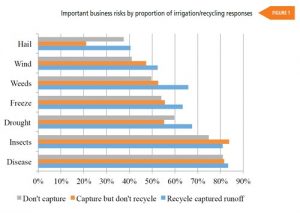
Disease management priority varies by irrigation/recycling category
In a subsequent question, respondents were asked to rate disease risk as a day-to-day management priority. Of 252 responses, 50 percent rated disease risk management as a “very important” priority (results not shown). However, the perceived importance of disease management as a priority differed somewhat across irrigation/recycling category. Respondents who capture runoff but don’t recycle were more concerned about disease management; 69 percent regarded disease management as a very important priority, as opposed to 63 percent of recyclers and only 58 percent of those who don’t capture. Less concern about disease among recyclers than among those who capture may indicate that they feel more successful at managing disease risk.
Perceived disease risk based on past experience
It should come as no surprise that perceptions of disease risk often depend on growers’ previous experience with disease. Across all firms, 83 of 220 nurseries (38 percent) responded that they typically lose 2 percent or less of sales to disease (Figure 2). Twenty nurseries (9 percent) reported typical disease losses equivalent to 5 percent or more of sales. Seven nurseries responded that they typically lose more than 10 percent of sales to disease, and none of these are recyclers. In terms of the maximum sales value ever lost to disease (data not shown), 133 nurseries (51 percent) reported that the maximum loss to disease was less than 2 percent of sales. However, 21 nurseries (10 percent) reported a maximum loss in excess of 10 percent of sales, and only one recycling nursery was among this high maximum loss group. In contrast, 13 nurseries that do not capture or recycle reported maximum losses in excess of 10 percent of sales. Recyclers appear to be more successful at managing extreme disease losses compared to other nurseries.
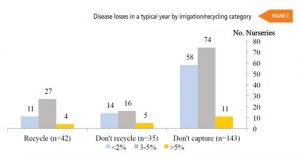
Phytophthora and Pythium
There are many disease vectors of ornamental plants; for example, insects, fungi, bacteria and viruses. Our project is focused on two important sources of ornamental plant disease: Phytophthora and Pythium (see sidebar). Application of untreated irrigation water carries the risk of introducing such waterborne pathogens. These risks increase when irrigation runoff is recycled. Once disease pathogens have entered a system, recirculated water can inoculate plants repeatedly. To evaluate the concern with Phytophthora or Pythium infestations, we asked survey respondents whether each pathogen was “not a problem,” an “insignificant problem,” a “problem” or a “significant problem.” Overall, 34 percent of nurseries considered Phytophthora as a problem or a significant problem, while 27 percent regarded Pythium as a problem or a significant problem. Recyclers had more problems with Phytophthora, with 48 percent of recyclers reporting disease caused by that pathogen as a problem or a significant problem, and 43 percent reported the same for Pythium. Figures 3 and 4 display how recyclers are more concerned about both these diseases, which is consistent
with the expectation that waterborne disease outbreaks are a persistent threat in recycling irrigation systems.
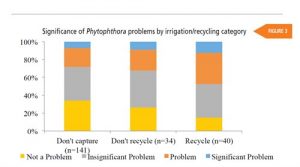
Disease prevention is important to nearly all nurseries
Respectively, 93 percent of recyclers, 83 percent of those who capture but don’t recycle, and 87 percent of those who don’t capture consider disease management and prevention to be important or very important. If disease risk is so important, why do responding nurseries indicate relatively few problems with the major diseases caused by Phytophthora and Pythium? An explanation may be found in the management activities employed to prevent disease damage (Figure 5).
Most respondents (61 percent) indicate that they regularly destroy potentially infected plants to prevent disease, and a somewhat higher proportion of recyclers (71 percent) report regularly using this practice. This “after the fact” disease management does not require knowledge of specific causes of disease, such as Pythium and Phytophthora. Higher plant destruction among recyclers likely is associated with their increased concern in avoiding disease risks. Overall, recyclers differ from non-recyclers in disease prevention methods only in their regular treatment of irrigation water (26 percent vs. 7 percent) and their use of fungicides (50 percent vs. 32 percent). Other methods regularly used by many growers to prevent disease include grouping plants with similar water needs, reducing water applications, or sanitizing the environment. Only a small proportion of respondents (6 percent) report having modified their irrigation system for disease prevention.
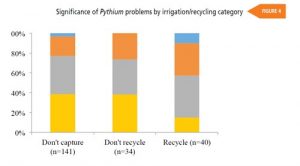
“State of the industry” for disease management and irrigation practices
Disease management
Because disease is reported as a principle source of financial risk, it’s not surprising that most businesses indicated that disease prevention was an important daily management activity. Across irrigation/recycling categories, 83 to 93 percent indicate disease prevention activities as “very important.” Nurseries manage disease risk through a combination of practices associated with runoff water treatment, irrigation water treatment, and other practices. If a threat of disease is suspected, virtually all nurseries are ready to apply chemicals for control of fungal diseases.
Runoff water treatment methods
Water treatment is conducted at various stages in the production process. In some cases, source water (such as well water) is treated prior to application. After watering production areas, captured runoff water is generally treated in some manner prior to either release or reuse. Treatments may differ depending on the intended water use; generally, runoff captured and re-applied to plants requires more treatment than runoff to be discharged. Treatment differences reflect differing objectives: Discharge water is generally treated for environmental reasons (for example, to control downstream nutrient levels) and/ or to comply with discharge regulations, whereas treatment of water intended for reuse is generally for disease mitigation. The survey distinguishes between methods used for treating runoff prior to capture or discharge (such as buffer strips, wetlands or erosion controls) and methods for treating irrigation water (such as chlorination or sand filters).
Figure 6 shows the proportion of respondents in each recycling category using each runoff treatment practice. Survey data indicate that a larger proportion of recyclers than other recycling categories utilize each runoff treatment. The majority of recyclers use buffers or groundcover, sediment basins, or grass waterways or rip-rap to runoff treatment. A small proportion of respondents also reported using other methods, such as erosion control and critical area stabilization (not reported in figure).
Nurseries that don’t capture runoff utilize relatively few runoff treatment practices, with buffers or groundcover used by only 18 percent of nurseries. Many nurseries that don’t capture reported using no runoff treatment practices. Runoff treatment is an important practice for state and federal water quality programs such as the Chesapeake Bay “pollution diet” established by the EPA ( http://www.chesapeakebay.net/blog/post/epa_establishes_chesapeake_bay_pollution_diet). Nurseries that do not capture or treat runoff are likely to receive increased attention from environmental agencies.
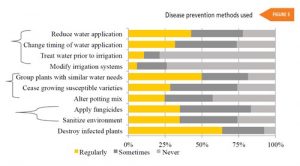
Irrigation water treatment
Fully 75 percent of the 259 irrigating nurseries used no form of irrigation water treatment. Nontreatment is closely associated with irrigation water drawn from wells, which is particularly common on small and medium nurseries. It should cause no surprise that recyclers are the most intensive users of irrigation water treatment methods. Chlorine or other disinfectants such as bromine were the most commonly used treatment methods. This likely reflects a cost advantage for disinfectants relative to other treatment methods. The second most common method was utilization of a sand filter. Only a few instances of other methods such as ultraviolet light or dye were reported.
Other practices to manage risk of waterborne diseases
A recommendation by the Irrigation Pathogens and Water Quality Project to reduce risk of Pythium and Phytophthora infestation is to prolong water residence time in storage prior to reuse. Nurseries in the survey were asked to indicate if they had received and implemented recommendations to adjust the number and size of collection ponds, alter water conveyance or alter pump location in order to reduce the potential for diseases caused by these pathogens. Responses indicated that fewer than 10 nurseries had implemented such a recommendation. The Project will be investigating further to estimate implementation costs of these cultural practices.
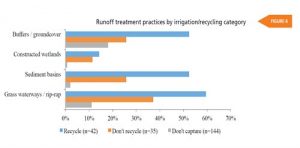
Costs of disease treatment
Left untreated, fungal diseases can destroy large portions of a nursery crop. A sometimes critical element of disease management is the application of fungicides. Seventy-four percent of surveyed nurseries applied fungicides. Table 1 shows average costs of fungicide materials, labor and equipment in dollars and as a percent of total nursery costs for those who responded to these questions. The data show that nurseries generally spend a higher proportion of total costs on fungicide applications than on water treatment. Although recycling nurseries reported higher fungicide costs than nonrecyclers, the average fungicide expenditure as a proportion of total costs is similar across irrigation categories, ranging from 4 to 16 percent.
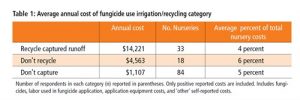
What we learned
Survey results suggest that disease is considered to be a top financial risk for ornamental plant growers. Across the spectrum of recycling categories, disease is consistently viewed as a key source of financial risk, but disease is a relatively greater concern for growers who currently capture at least some production runoff, but do not recycle. In contrast, the recycling nurseries appear to be more successful in disease management and have experienced a lower incidence of major disease losses. The data suggest that while disease risk is perceived to be a barrier to recycling, that risk is well managed by recyclers who use water treatment and disease management practices.
The aim of the irrigation pathogen project is to assist growers to adopt “pre-emptive” disease management measures rather than relying on costly reactive measures (destroying plants). The project offers research-based advice on best management practices for irrigation and recycling system design and operation in order to minimize disease risk in ornamental plant operations.
Gwendolyn Rees is a research assistant in the Department of Agricultural and Applied Economics at Virginia Tech University; she can be reached at [email protected]. Alyssa Cultice is an Environmental Scientist at PG Environment LLC in Herndon, Virginia; she can be reached at [email protected]. James Pease, Darrell Bosch and Kevin Boyle are Professors in the Department of Agricultural and Applied Economics at Virginia Tech University; they can be reached at [email protected], [email protected] and [email protected], respectively.
References
Cultice, Alyssa K. 2013. Horticultural Producers’ Willingness to Adopt Water Recycling Technology in the Mid-Atlantic Region. M.S. Thesis. Department of Agricultural and Applied Economics, Virginia Tech, Blacksburg, Virginia. July 7, 2013. Retrieved from http://hdl.handle.net/10919/49455.
Hong, C. X. 2014. Component analysis of irrigation water in plant disease epidemiology Page 111- 121 In: Biology, Detection and Management of Plant Pathogens in Irrigation Water. Hong, C. X, Moorman, G. W., Wohanka, W. and Buettner, C. (eds.) American Phytopathological Society, St Paul, MN
Moorman, Gary. “Phytophthora Root Rot on Woody Ornamentals”. Penn State Extension. (2010a). Retrieved from http://extension.psu.edu/pests/plant-diseases/all-fact-sheets/phytophthora- root-rot-on-woody-ornamentals
Moorman, G. “Pythium”. Penn State Extension. (2010b). Retrieved from http://extension.psu.edu/plant-disease-factsheets/all-fact-sheets/pythium